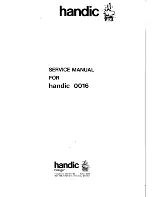
26
TK-880
Frequency Configuration
The TX-RX unit (A/2) incorporates a VCO, based on a frac-
tional N type PLL synthesizer system, that allows a channel
step of 5, 6.25, and 25kHz to be selected. The incoming
signal from the antenna is mixed with a first local oscillation
frequency to produce a first intermediate frequency of
44.85MHz.
The signal is then mixed with a second local oscillation
frequency of 44.395MHz to produce a second intermediate
frequency of 455kHz. This is called a double-conversion
system. The TX-RX unit (A/2) contains a wide/narrow MCF
and CFs. The transmit signal is produced by the PLL circuit
for direction oscillation and division. The signal output from
the VCO is amplified by a straight amplifier and transmitted.
Fig. 1
Frequency configuration
Receiver System
■
Outline
The incoming signal from the antenna passes through a
low-pass filter and a transmission/reception selection diode
switch (D209) and goes to the front end of the receiver.
As for E,E4 type, the front-end filter is a variable BPF con-
sisting of two two-pole helical resonators and eight varicap
diodes (D203, D204, D205, D206, D212, D213, D214, D215)
to eliminate unwanted out-of-band signal components.
While the E3 type, the front-end filter is a variable BPF,
consisting of six coils (L901, L903, L904, L906, L908, L909)
and two varicap diodes (D902, D903) to eliminate the un-
wanted out-of-band signals.
The low-noise amplifier (LNA) (Q201) uses a bipolar tran-
sistor to achieve wide-band and low-distortion amplification.
The signal passes through a BPF and is down-converted
with the first local signal by IC200, then converted to the
first IF signal of 44.85MHz. The first local signal passes
through an LPF and an attenuator to eliminate unwanted
harmonics components and implement the optimum input
level to the mixer, then enters IC200. A DBM is used as a
mixer to achieve a high potential.
The signal output from the mixer is amplified by an inter-
mediate frequency amplifier and input to two MCFs (XF1).
The signal is amplified by another intermediate amplifier and
goes to the FM IF IC (IC11). The first intermediate fre-
quency signal is mixed with the second local signal of
44.395MHz to produce the second IF signal of 455kHz.
The unwanted near-by signal components are then elimi-
nated by a wide ceramic filter (CF1) or a narrow ceramic fil-
ter (CF2) and the resulting signal goes back to the FM IF IC.
The signal is quadrature-detected in the IC to produce an
audio signal, which is amplified by a DET amplifier (IC2) and
output to the TX-RX unit (B/2).
■
Wide/Narrow Changeover Circuit
The W/N port (pin 11) of the shift register (IC7) is used to
switch between ceramic filters. When the W/N port is high,
Q24 turns on and the ceramic filter SW diode (D22, D23)
CF1 turns on to receive a Wide signal. At the same time,
Q16 turns on and one of the filters is selected so that the
wide and narrow audio output levels are equal.
When the W/N port is low, Q23 turns on and the ceramic
filter SW diode (D22, D23) CF2 turns on to receive a Narrow
signal.
Fig. 2
Receiver system
CF1
(Wide)
CF2
(Narrow)
IFI
MXO
IC11
IF system
AFO
DET
OUT
C107
C100
C108
R114
R123
R133
R126
R125
R130
R131
+
+
Q16
DM
Q32
R121
W/N
IC7 11pin
Wide : H
Narrow : L
C118
D22
D23
Q23
5C
Q24
Wide : L
Narrow : H
Fig. 3
Wide/Narrow changeover circuit
CIRCUIT DESCRIPTION
ANT
SW
RX
AMP
1st
MIX
TX
AMP
POWER
AMP
CF 455kHz
(Wide)
CF 455kHz
(Narrow)
MCF
44.85MHz
+
–
MIX/IF/DET
395.15~
425.15MHz : E,E4
361.15~
405.15MHz : E3
PLL/VCO
VCXO
16.8MHz
440~470MHz : E,E4
406~450MHz (RX) : E3
406~432MHz (TX) : E3
440~470MHz : E,E4
406~432MHz : E3
44.395MHz
AFO
MD
MB
LPF
ANT
BPF
BPF
Q201
AMP
Q15
AMP
IC2
AMP
IC200
MIX
XF1
BPF
D211
D209,210
ANT
SW
+
–
Q203
AMP
CF1/
CF2
IC11
MIX,IF,DET
X2
2nd
local OSC
1st local
OSC (HT)
DEO
Содержание TK-880 series
Страница 71: ...TK 880 TK 880 TK 880 95 BLOCK DIAGRAM ...
















































